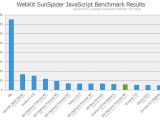The latest development milestone of Internet Explorer 9 released at PDC 2010 is almost three times as fast as the first preview of the browser introduced just a year ago at PDC 2009, in terms of the WebKit SunSpider version 0.9.1 JavaScript Benchmark.
IE9 Platform Preview #6 wraps up SunSpider in 292 ms, and is the fourth fastest browser according to Microsoft’s test, outran only by Chrome 7 (7.0.517.41) with 257 ms, Opera 10.6.1 with 246 ms and Chrome 8 Nightly (8.0.552.11) with 241 ms.
Customers will be able to see via the graphic included below that IE9 PP6 manages to outperform releases such as Firefox 4.0 Beta 6, and Safari 5.0.2 in terms of JS performance.
But at the same time, users must understand that JavaScript speed is not synonymous with overall browser performance.
“Platform Preview 6 continues improvements to individual sub-systems, like the JavaScript engine. One measure of JavaScript performance is the Webkit Sunspider microbenchmark.
“The differences between browsers on this microbenchmark are converging within thousandths of seconds on tests that repeat operations many, many times to find any differences at all,” revealed Dean Hachamovitch, Corporate Vice President, Internet Explorer.
The Corporate VP of IE underlines that the true test of browser performance is in real-world scenarios. While SunSpider essentially focuses only on the JS engine, codenamed Chakra in the case of IE9, users browsing the web will need all the browser’s subsystems, and not just JavaScript.
Microsoft has two samples on the IE Test Drive site designed to illustrate browser performance in real-world site patterns. Users should make sure to check out browser hunt and speed reading.
“Engineers design microbenchmarks to isolate and exercise very narrow and specific aspects of a system. That’s the opposite of real-world websites that use the different subsystems together in order to deliver something useful or entertaining,” Hachamovitch added.
Measuring the performance of a browser, subsystem by individual subsystem, is inherently flawed because it’s not how real sites work.”
And there are additional IE Test Drive demos that testers should have a look at, the new SVG Helicopter, the Track splash and the customer model.
The first can be ran into browsers that support both SVG and HTML5 audio, while the second is focused on HTML5 video interacting with canvas elements, with the last dealing with SVG in zoom in and out scenarios.
“The issue isn’t a specific flaw in a particular benchmark, but that the results so often have little in common with the actual user experience of the larger system when browsing sites.
“Microbenchmarks of ray tracing or Fourier transforms matter a lot if the sites you rely on use them. A ten percent difference in one JavaScript benchmark often translates to no actual difference in real sites. All benchmarks have some variability in measurement.
“When benchmarks run other benchmarks in turn, the errors often add up instead of cancelling. This post offers a good survey of what several different microbenchmarks measure,” Hachamovitch said.
Internet Explorer 9 (IE9) Build 9.0.7930.16406 is available for download here.
Internet Explorer 9 (IE9) Platform Preview 6 (PP6) is available for download here.

 14 DAY TRIAL //
14 DAY TRIAL // 
